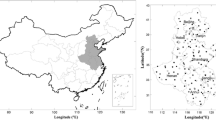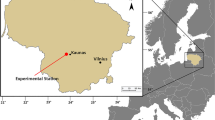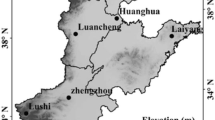Abstract
Weather and climate variability are predicted to impact food security by altering crop growth, phenology, and yield processes. Adaptation measures are critical for reducing future vulnerability of crop production to warming weather and climate variability. It is therefore vital to investigate the shifts in crop phenological processes in response to weather/climate variability. This study analyzes the trends in the dates of winter wheat (Triticum aestivum L.) phenology in relation to average temperature of different growth stage and the adaptation of the crop to weather/climate variability in China. The results suggest that the phenological phases of winter wheat have specific regional patterns in China. There are also significant shifts in the dates of winter wheat phenology and the duration of the growth stages in the investigated 30-year period of 1980–2009. While the date of sowing winter wheat delays, the dates of post-winter phenological phases (e.g., heading and maturity dates) advances in most areas of China. Detailed analysis shows that the changes in the phenological phases of winter wheat are strongly related to temperature trends. Temporal trends in phenological phases of winter wheat are similar in characteristics to corresponding trends in temperature. Although warming weather and climate variability is the main driver of the changes in winter wheat phenology, temperature is lower than before in most of the investigated stations during the period from heading to maturity—mainly the grain-filling stage. This is mainly due to the early heading and maturity dates, which in turn not only prolong growth stages but also enhance productivity of winter wheat. This could be a vital adaptation strategy of winter wheat to warming weather with beneficial effects in terms of productivity.







Similar content being viewed by others
References
Biscoe PV, Gallagher JN (1977) Weather, dry matter production and yield. In: Land JJ, Cutting CV (eds) Environmental effects on crop physiology. Academic, London, pp 75–100
Chmielewski FM, Müller A, Bruns E (2004) Climate changes and trends in phenology of fruit trees and field crops in Germany, 1961–2000. Agric For Meteorol 121:69–78
Craufurd PQ, Wheeler TR (2009) Climate change and the flowering time of annual crops. J Exp Bot 60:2529–2539
Ding YH, Ren GY, Shi GY, Gong P, Zheng XH, Zhai PM, Zhang DE, Zhao ZC, Wang SW, Wang HJ, Luo Y, Chen DL, Gao XJ, Dai XS (2006) National assessment report of climate change (I): climate change in China and its future trend. Adv Clim Chang Res 2:3–8 (in Chinese with English abstract)
Diskin E, Proctor H, Jebb M, Sparks T, Donnelly A (2012) The phenology of Rubus fruticosus in Ireland: herbarium specimens provide evidence for the response of phenophases to temperature, with implications for climate warming. Int J Biometeorol 56:1103–1111
Estrella N, Sparks TM, Menzel A (2009) Trends and temperature response in the phenology of crops in Germany. Global Change Biol 13:1737–1747
Hu Q, Weiss A, Feng S, Baenziger PS (2005) Earlier winter wheat heading dates and warmer spring in the US Great Plains. Agric For Meteorol 135:284–290
IPCC (2007) Climate change 2007: synthesis report. Inter-governmental Panel on Climate Change. Cambridge University Press, Cambridge
Kelman WM, Dove H (2009) Growth and phenology of winter wheat and oats in a dual-purpose management system. Crop Pasture Sci 60:921–932
Lieth H (1974) Phenology and seasonality modeling. Springer, Berlin
Menzel A (2002) Phenology: its importance to the global change community. Clim Chang 54:379–385
Menzel A, Sparks TH, Estrella N et al (2006) European phenological response to climate change matches the warming pattern. Glob Chang Biol 12:1969–1976
Misra AK (2013) Climate change impact, mitigation and adaptation strategies for agricultural and water resources, in Ganga Plain (India). Mitig Adapt Strateg Glob Chang 18:673–689
Moradi R, Koocheki A, Nassiri Mahallati M, Mansoori H (2013) Adaptation strategies for maize cultivation under climate change in Iran: irrigation and planting date management. Mitig Adapt Strateg Glob Change 18:265–284
Myneni RB, Keeling CD, Tucker CJ, Asrar G, Nemani RR (1997) Increased plant growth in the Northern High Latitudes from 1981 to 1991. Nature 386:698–702
Porter JR, Gawith M (1999) Temperatures and the growth and development of wheat: a review. Eur J Agron 10:23–36
Siebert S, Ewert F (2012) Spatio-temporal patterns of phenological development in Germany in relation to temperature and day length. Agric For Meteorol 152:44–57
Sneyers R (1975) Sur l'analyse statistique des series d'observations, Tech. Note, 194, WMO, Geneva, p. 9–12
Stacks WJ, Deryng D, Foley JA, Navin R (2010) Crop planting dates: an analysis of global patterns. Glob Ecol Biogeogr 19:607–620
Tao FL, Yokozawa M, Xu YL, Hayashi Y, Zhang Z (2006) Climate changes and trends in phenology and yields of field crops in China 1981–2000. Agric For Meteorol 138:82–92
Thornton P, Running S, White M (1997) Generating surfaces of daily meteorological variables over large regions of complex terrain. J Hydrol 190:214–251
Tingem M, Rivington M (2009) Adaptation for crop agriculture to climate change in Cameroon: turning on the heat. Mitig Adapt Strateg Glob Chang 14:153–168
Van Bussel LGJ, Ewert F, Leffelaar PA (2011) Effects of data aggregation on simulations of crop phenology. Agric Ecosyst Environ 142:75–84
Xiao DP, Tao FL (2013) Contributions of cultivars, management and climate change to winter wheat yield in the North China Plain in the past three decades. Eur J Agron. doi:10.1016/j.eja.2013.09.020
Xiao DP, Tao FL, Liu YJ, Wang M, Liu FS, Zhang S, Zhu Z (2013) Observed changes in winter wheat phenology in the North China Plain for 1981–2009. Int J Biometeorol 57:275–285
Zheng JY, Ge QS, Hao ZX (2002) Impacts of climate warming on plants phenophases in China for the last 40 years. Chin Sci Bull 47:1826–1831
Acknowledgments
This study is supported by the National Science Foundation of China (Project No. 41071030), the Science and Technology Strategic Pilot Project of Chinese Academy of Sciences (Project No. XDA05090308), the National Key Program for Developing Basic Sciences in China (Project No. 2010CB950902), and Science Foundation of Hebei Academy of Sciences (Project No. 13123). We acknowledge the invaluable comments of the anonymous reviewers during the manuscript stage.
Author information
Authors and Affiliations
Corresponding author
Electronic supplementary material
Below is the link to the electronic supplementary material.
Appendix S1
(DOCX 27 kb)
Rights and permissions
About this article
Cite this article
Xiao, D., Moiwo, J.P., Tao, F. et al. Spatiotemporal variability of winter wheat phenology in response to weather and climate variability in China. Mitig Adapt Strateg Glob Change 20, 1191–1202 (2015). https://doi.org/10.1007/s11027-013-9531-6
Received:
Accepted:
Published:
Issue Date:
DOI: https://doi.org/10.1007/s11027-013-9531-6




